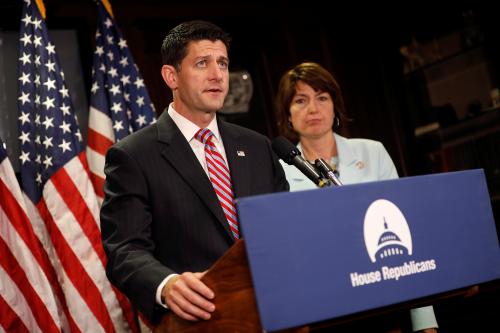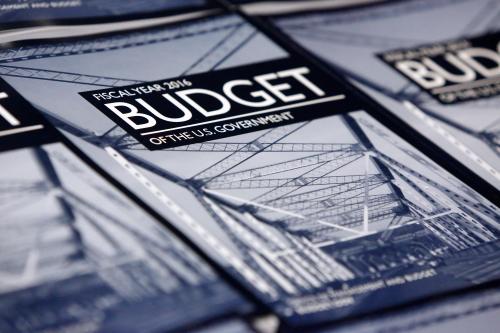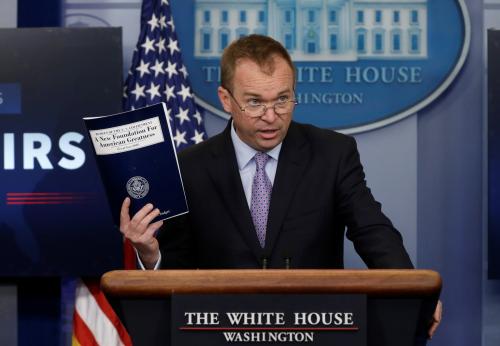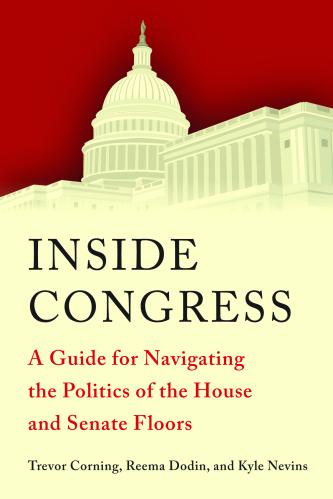Vital Statistics on Congress is a regular publication of the Brookings Institution. Since its first publication in 1980, it has become a go-to reference guide for those interested in congressional affairs. This blog is the sixth in a series that will highlight interesting data trends in each chapter of the most recent update, released January 2017.
Now that the House of Representatives and the Senate have approved identical versions of the annual congressional budget resolution, Congress has checked its first box on the path to potentially passing major tax legislation on a party-line basis, without the possibility of a filibuster. When the House first took up the budget resolution, its draft included in the resolution calls for approximately $200 billion in mandatory spending cuts over the next decade. The Senate rejected the House’s proposed cuts, instead adopting a resolution more focused on tax changes. This isn’t unusual. As Molly Reynolds wrote in August, we often see changes made to House budget proposals before final adoption.
But, what does this tell us about broader budget trends in Congress?
Mandatory spending is spending governed by statute, rather than the annual appropriations process and it constitutes most of the transfer payments millions of Americans rely on.
As the latest update of Vital Statistics on Congress shows, this category of spending has grown tremendously in the 21st century and comprised 69% of federal outlays in 2016. The figure below demonstrates not only how the total amount has grown over time, but how that growth has been largely concentrated in a few programs. Entitlement programs such as Social Security, Medicare, and Medicaid comprise the largest share of mandatory spending and have been largely responsible for driving the growth. Other smaller mandatory programs include unemployment compensation, Supplemental Security Income, housing assistance, and others popularly classed as “welfare,” identified as “Direct Payments to Individuals” in the chart below. (This category also includes some additional programs, such as the Earned Income Tax Credit and income security for veterans.)

The original House budget resolution involved cuts to 11 different authorizing committees in the House, ranging from a directive to the Ways and Means Committee to save at least 52 billion over 10 years to just $1 billion each in cuts to the Veteran’s Affairs and Armed Services Committees jurisdictions. Cutting mandatory spending through the budget reconciliation process can be challenging, even in the absence of the threat of a filibuster. First of all, it’s worth noting that not all mandatory spending is on the table in the reconciliation process. Due to the Senate’s Byrd Rule, reconciliation bills may not “contain recommendations regarding the OASDI (Social Security) trust funds,” eliminating one possible source of savings. Second, the programs that comprise the largest share of spending are also among the most popular. Medicaid cuts, for example, proved to be a contentious issue with Senate Republicans during the latest debate over repealing and replacing the ACA through the “Graham-Cassidy” bill last month, eventually contributing to the total derailment of the effort.
If Congress had pursued the House’s mandatory spending cuts, what might they have looked like? Marc Goldwein of the Committee for a Responsible Federal Budget provided The Hill with an outline of possible legislative changes that could get the House to their $203 billion target. Importantly, Congress would have been able to make those legislative changes with a party-line vote in the Senate, due to reconciliation rules which protect legislation from being filibustered. Such a vote on legislation to cut mandatory spending would also make it very easy for the Democrats to accuse the Republicans of gutting such popular programs as Medicare and Medicaid. No wonder the Senate Republicans chose not to include the cuts in the reconciliation instructions, making any mandatory spending cuts extremely unlikely to happen.
Despite House Speaker Paul Ryan’s (R-Wis.) repeated assurances that the final budget would be deficit-neutral, eagerness to start work on tax reform has forced the House to abandon their cuts in favor of legislative expediency. Yesterday, the House voted to adopt the Senate version of the budget resolution, which allows a deficit increase of $1.5 trillion over ten years intended to accommodate tax cuts. The Republican Study Committee, a powerful coalition of conservative House Republicans, were initially hesitant about the deficit-financed plan. They reluctantly approved it last week, allowing the full House to move forward with the Senate version, with the explicit goal of quickly moving on to tax reform. Now that the budget is finalized, the next battle will be crafting a piece of tax reform legislation that can get the approval of not just the House and the Senate, but the President as well.









Commentary
Mandatory spending cuts get left behind in Congress’s march toward tax reform
October 27, 2017